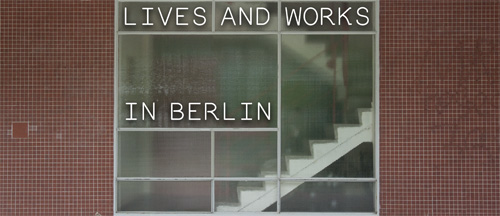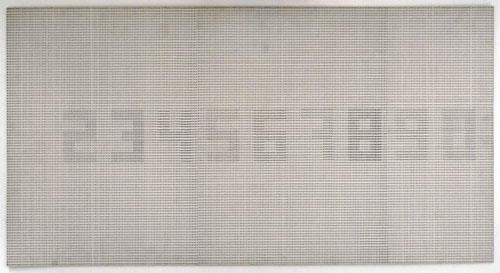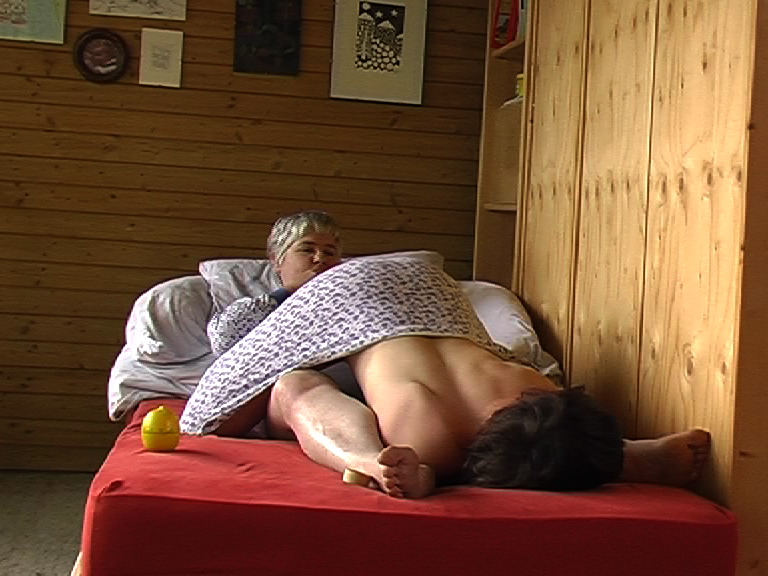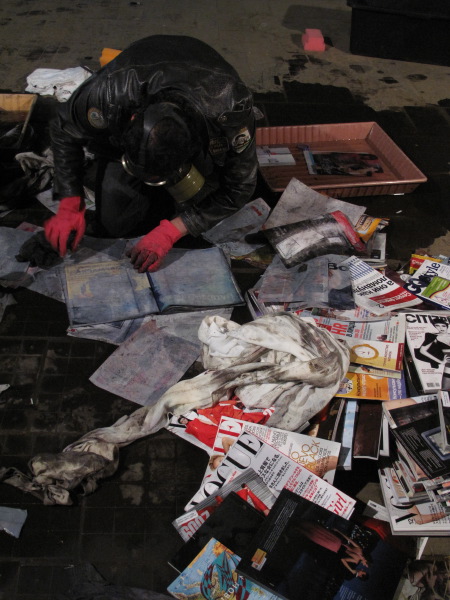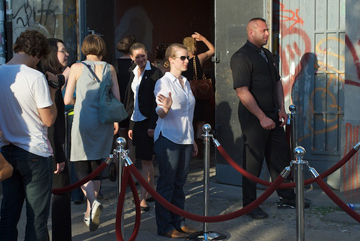Aligning smoothly with the start of Art Basel for the first time, the 6th Berlin Biennial for Contemporary Art (BB6) opened this past week, two months later than its previous April time slot. While this meant that Berlin’s gallerists had to juggle between the openings of their own summer shows and a smooth departure to Switzerland, art buffs and collectors from abroad seem to have appreciated the synchronization of the two major art events — similar to 2007’s “Super European Art Tour”: Skulptur Projekte Münster (every 10 years) / Documenta XII (every 5 years) / 52nd Venice Biennale (every 2 years) / Art Basel 38 (every year).
While using multiple alternative exhibition venues is standard practice for the Berlin Biennial, the BB6 marks the first major departure from Berlin-Mitte and the location of its central hub, KW Institute of Contemporary Art. With six different sites, mostly located to the south in the district of Kreuzberg, the Biennial asks its audience to consider more rough and tumble situations in which to view art. Although the drive to stake out new neighborhoods is nothing new for Berlin’s art crowd, it seems this curatorial decision is fueling the discussion about the gentrification of (already hip) neighborhoods, such as Kreuzberg. Below, Art21’s Berlin columnists discuss this shift in locale among other developments in the 6th iteration of the Berlin Biennale.
Anna Milandri
The atmosphere of major Berlin arts events often hinges on the city’s unpredictable weather patterns. Fate had it that Thursday evening’s opening of the 6th Berlin Biennale coincided with the hottest day of the year to date, and so after a tour through the different locations surrounding Oranienplatz, most attendees found themselves on beer benches or sitting on the grass, sipping cold beers from local kiosks.
While Oranienplatz — a city square in the middle of Kreuzberg 36 — is certainly not exempt from the rapid changes visible all over the city, it is still a long ways away from the renovated district of Mitte and the heart of the Biennale, the KW Institute for Contemporary Art. The regulars sitting on the benches of Oranienplatz usually include those that live in the area: elderly Turkish men having a chat, teenagers smoking cigarettes, punks having a beer, mothers rocking baby strollers. For the duration of the Biennale, Vietnamese-born Canadian artist Ron Tran has moved these benches closer together, so that people sitting on one side are now facing those opposite at a distance of about 1.5 meters. While not quite uncomfortably close, one can no longer easily ignore his counterpart. Tran’s work does not implicitly comment on the gentrification process that big arts events (such as this one) help to accelerate, but the piece could be read as symbolic for the complicated relationship this 6th Berlin Biennale forms with its venue locations and their neighbors. It will be interesting to see whether this relationship develops into one of mutual disregard or one of real interaction.
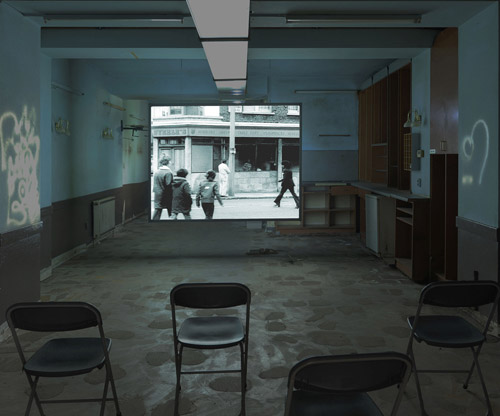
John Smith, "The Girl Chewing Gum," 1976. Installation view, 6th Berlin Biennale for Contemporary Art. Courtesy the artist; Tanya Leighton Gallery, Berlin. Photo: Uwe Walter, 2010.
The Girl Chewing Gum (1976), one of the innumerable film and video works featured in the 6th Berlin Biennial for Contemporary Art, is very likely one of John Smith‘s masterpieces. Off-camera, a shouting voice directs, in an oft-humorous yet deadpan manner, the normal day-to-day goings-on of a busy London street corner. Shot on grainy black and white film, the visual qualities of The Girl Chewing Gum relate nicely to the graphic, high-contrast, typographically-oriented photographs of Shannon Ebner, despite being exhibited at venues in different neighborhoods in Berlin.
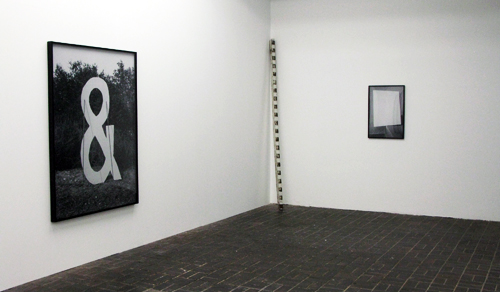
Installation view of Shannon Ebner in the 6th Berlin Biennale for Contemporary Art. Photo: Ethan Hayes-Chute.
Also set rather far away from the central hub of the biennial, KW (Kunst Werke), are the strangely perverse and claustrophobic videos of George Kuchar, which are presented in a similarly perverse and claustrophobic manner (22 video monitors in one hot, stuffy room) — a good portion of which depict Kuchar holed-up in his motel room in Oklahoma fretting about the weather outside and the possibility of a tornado touching down.
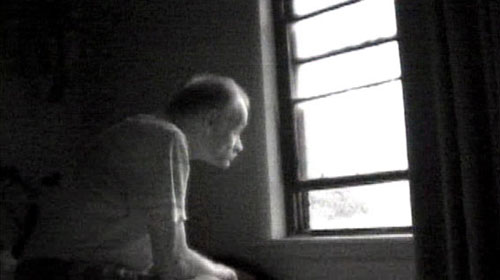
George Kuchar, "Centennial," 2007. DVD, color, sound 13'14''. Courtesy the artist and the Video Data Bank, Chicago.
Running concurrently with the biennial, Sophia Hultén‘s Past Particles at Konrad Fischer takes everyday objects (a tool box, a set of broken windows, small objects often found on a workshop floor) and stretches their functionality, with wit and simple ingenuity. Zak | Branika‘s Minimum Maximum showcases mid-70s work by Stanisław Dróżdż, Carl Andre, and Robert Barry, consisting mostly of incredibly obsessive typewriter works that could put any present-day ASCII artist to shame (no undo!).
This weekend also inaugurated the new location and impressive new exhibition space belonging to the Kunstlerhaus Bethanien, which recently moved from its longtime home a few blocks away amid turmoil and aggravation fueled by local politics and pesky and persistent squatters.
The Berlin Biennale is a fascinating study in social space and shock-and-awe gentrification as the art elite, often in dress unfit for adventure, find themselves shimmying down staircases of indeterminate material or slinking into gritty studio apartments (as is the case with Danh Vo’s modest contribution of his own apartment this year).
Given Biennale curator Kathrin Rhomberg’s interest in a firmer engagement with social realities and a more stringent realism, it makes sense that most of the venues are in Kreuzberg and that many of the video artists included are Frederick Wiseman devotees who rely on the dictates of political documentary. But unfortunately, at the Oranienplatz space, individual works dissolve into a kind of “protest ambiance” marked by swiveling camera work, escalating voices, and the occasional sound of street fire.
Some of the more successful pieces depart from the meandering pace of investigative journalism in favor of a more distended reality.
Andrey Kuzkin‘s manic Resistance (2009) reaches the same disquieting speed of a Ryan Trecartin video without the stretch pants or dorm room vertigo. In an incredible act of brute force and frustration, Kuzkin scours the glossy visages of women from chemically steeped issues of Vogue and other high fashion mags.
Phil Collins‘s Marxism Today (Prologue) (2010) is an engrossing and uptempo look into the reunification struggles of Marxist-Leninist educators from the former GDR. Set to an emo Stereolab soundtrack and undeniably slick, the monologues are interspersed with East German educational material and sexy footage from the 1988 Seoul Olympics.
Ana Witt‘s Die Geburt (2003) shows the artist naked and twitching under her mother’s surprisingly elastic gown in an unnerving yet touching recreation of the womb. The artist’s head lies stubborn and content along her mother’s leg in a gesture that, while not overtly political, is apropos in a time of threatened survival and tenaciously guarded personal freedoms.
Alex Freedman
Given a sizable portion of the KW Institute, Petrit Halilaj bolted reconstructed beams of his family’s Runik, Serbia home to the ceiling before letting his signature bourgeois hens loose to mingle with visitors. A floor up is a selection of drawings, videos, and installations which continue the theme of flightless birds as a metaphor for rural-to-urban migration. A surreal exploration of intergenerational dreams, Halilaj’s work is smart and subtle, making it this politically heavy Biennale’s comic relief.
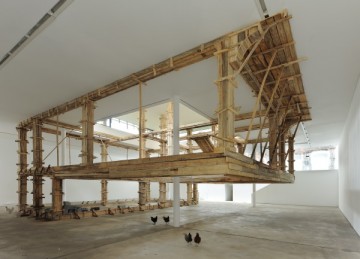
Petrit Halilaj, "The places I’m looking for, my dear, are utopian places, they are boring and I don’t know how to make them real," 2010. Installation View, 6th Berlin Biennale for Contemporary Art. Dimensions variable. Photo: Uwe Walter, 2010. Courtesy the artist. Copyright the artist and Chert, Berlin.
But over at Oranienplatz, the “hens” weren’t feeling so free last Friday night. Marlene Haring‘s performance Door Policy, or, Biting the Hand That Feeds Me transformed BB6’s gender ratio into a policy of admitting 12 females for every 33 males during the public opening. Unfortunately, a lack of signage led to viewer frustration over the WC-like queues. Responding to the disgruntled public, the policy was temporarily altered to women-only, sparking another more important debate: which line would RuPaul stand in?
Haring’s work wasn’t the only effort mangled by bad signage and public perplexity. Staging a move to defend their turf, the makers of Forgotten Bar launched the 1st Berlin Kreuzberg Biennale for Contemporary Art. At times witty, othertimes jejune, the Kreuzberg Biennale maps onto the Kiez an ambitious roster of nearly 50 works, including Christian Jankowski‘s classic video The Hunt, now on view at the Cafe Schönlein Backerei. The only trouble is that by Monday, several signs had been stolen, transforming this art walk into a search mission, as scores of work became undecipherable from the area’s mosaic of graffiti and event posters. Yet the show’s precarious future levels a potent critique for assessing the Berlin Biennale’s temporary foray into the neighborhood: while one show assimilates to its environs, the other will pack up and leave.
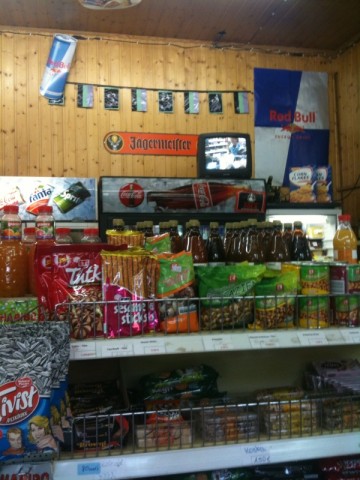
Christian Jankowski, installation view of "The Hunt," 1992, at Cafe Schönlein Backerei, Kreuzberg Biennale for Contemporary Art. Photo: Alex Freedman, 2010.
German-born Anna Milandri is an artist currently based in Berlin, where she recently completed her MA. Her research interests include 19th century landscape garden architecture, early optical devices and anthroposophic cults of the Pacific Northwest.
Ethan Hayes-Chute makes art in Berlin, where he thinks about hypothetical domiciles, fantastical isolation, outsider architecture, self-sufficiency, landscape, self-preservation, rusty nails, viewer participation, found materials, daily life, nostalgia, seclusion, sublimity, ad-hoc construction, knick-knacks, craftsmanship, customization, longing and decay. He can often be spotted towing a wagon overflowing with cast-off wood and other special acquisitions.
Ali Fitzgerald is an artist and writer living (and occasionally working) in Berlin. She is represented by Art Palace in Houston, TX and her work can be found in the Drawing Center’s Viewing Program. Ali also just started a Berlin comic diary, found here.
Alex Freedman is an arts voyeur, archivist, and member of the Berlin-based curatorial collective 10/2/10. Her current projects include Look Until Blind, a Berlin-based artist interview project and a Cairo-based Internet artist curatorial initiative to be launched later this year.

